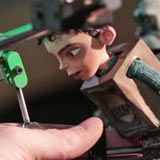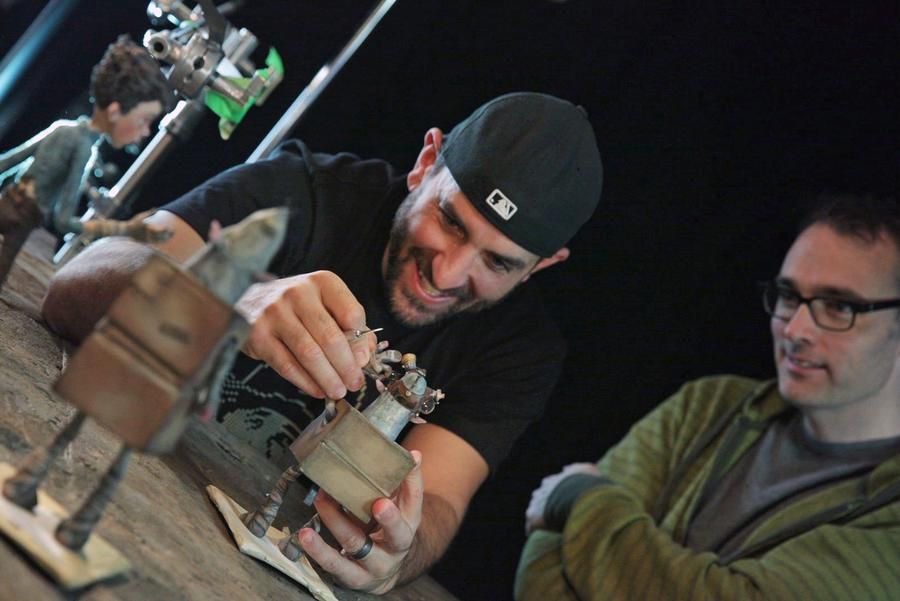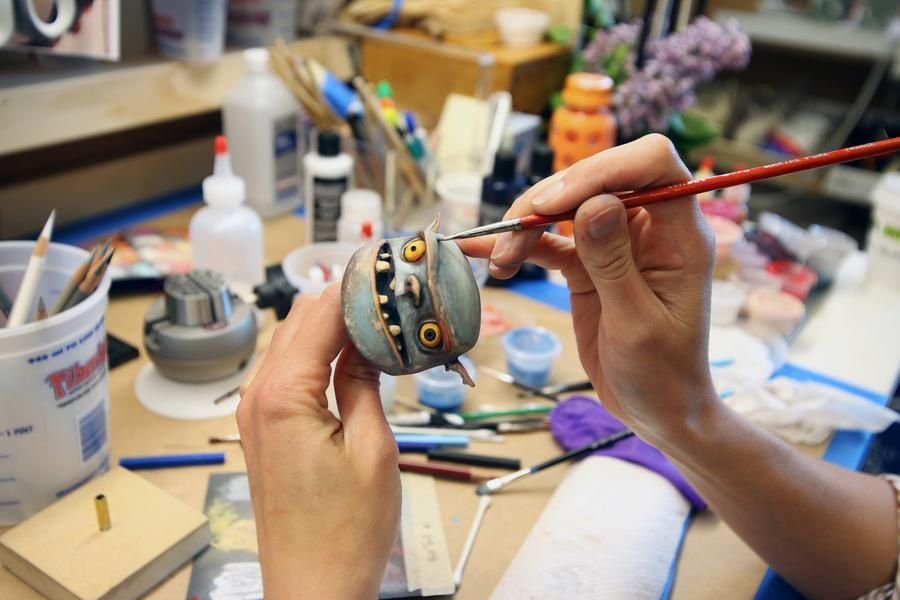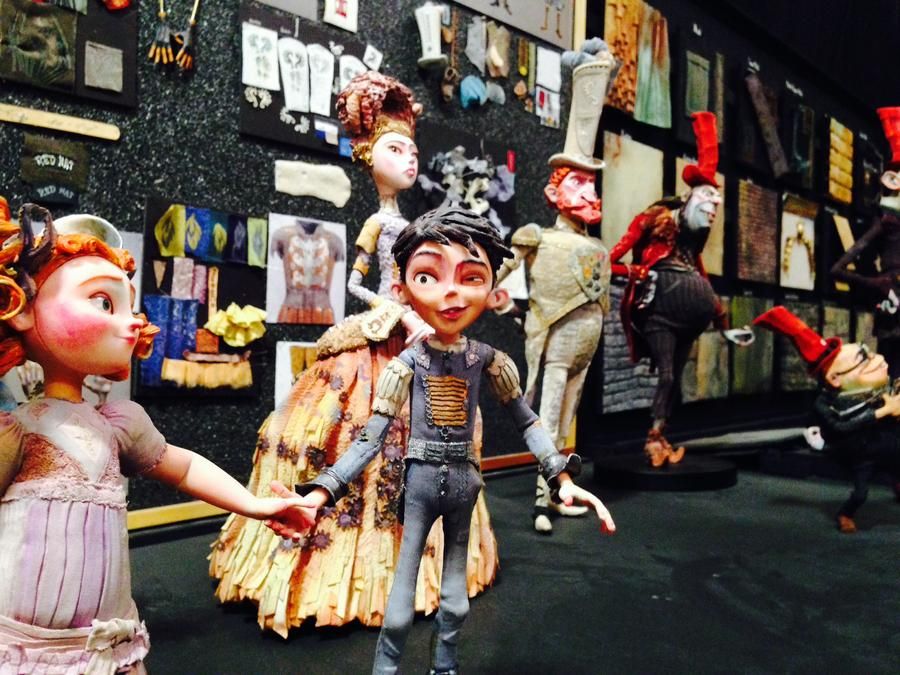If your notion of stop-motion animation still lingers somewhere between the era of the venerable Rankin-Bass holiday specials and the instant-classic The Nightmare Before Christmas, prepare to have your hair blown back.
Laika, the Portland, Oregon, animation studio that has won acclaim for pushing the long-standing but occasionally out of favor animation technology to bold new places while also telling engaging, entertaining film stories in films like Coraline and ParaNorman, moves the bar even higher with The Boxtrolls. A witty, stylish romp within a twisted fairy tale wrapping that fuses Dickensian environs with Gilliam-esque quirks and eccentricities, the film is a marvel for the seamlessly fluid quality of its visuals and the amazing level of detail rendered in its characters and sets, all in a rich 3D that puts much of Hollywood's CGI-rendered imagery to shame.
RELATED: ‘The Boxtrolls’ Star Elle Fanning Talks Accents, Stop-Motion and Obsessions
Co-directors Graham Annable and Anthony Stacchi reveal to SPINOFF ONLINE how they took on the challenge of one-upping even Laika's impressive stop motion output, the technologies they used to move the quality forward and the old school animation that inspired their longtime love of the stop motion technique.
Spinoff Online: One of the things that really struck me about the movie was the timeless quality. A lot of animated films in particular really lean on pop cultural references and in jokes, and this one kind of veered completely away from it but was just as entertaining and funny. When did you make that decision, and how did you arrive at that point?
Anthony Stacchi: When we first read Alan Snow's book [Here Be Monsters!], which is full of lots of crazy, inventive stuff, but it doesn't have any of those contemporary references. It's very Charles Dickenslike, very Dickensian. It does have a steam punk sensibility, but also, mostly, it has Alan Snow's sensibility -- which is he loves history and weird anachronistic history where stuff was invented sooner than you thought. Like cardboard was invented a lot sooner than [it was in actual history] -- you know, I incorporated that in his story and added this really fantastic element. So none of that stuff was really present in his world, so it would have taken a really conscious effort to say we're going to turn this into a sort of smart aleck-y contemporary reference joke fest, because it wasn't in the original material.
Graham Annable: It wasn't the movie we wanted to make. Yeah, it just didn't make sense.
Stacchi: Travis wouldn't have allowed it! [Laughter]
This team has been responsible for some successful films. What were the standards that you wanted to maintain with this one, and how did you want to push things forward?
Annable: I think with this film -- with each of the films -- and all of the departments, Travis has really pushed for us to continue to grow, expand what we do. And we've been really lucky that we've kept the same core group of folks together now for three films.
Stacchi: Yeah, that never happens.
Annable: Each department has just gotten better and more refined at what they did, and we knew early on for The Boxtrolls, one of the things we really wanted to challenge ourselves with was we were going to make for the first time a comedy adventure stop motion movie. I mean, up to that point, most stop motion movies tend to be a little on the dark side, a little more gothic -- supernatural, ghosts. It just seems to be where the material naturally gravitates to. So we really wanted to try to make something bigger and brighter: a big, bright family film. And The Boxtrolls was kind of the result of that. It definitely pushed the studio in a lot of new areas.
What do you love about the process, because, it's a painstaking one?
Stacchi: The look of it, you know? Ultimately, the look. The way we like to say it is that everybody has memory deep in their DNA of playing with dolls or a model train set or toys or trucks and manipulating them in front of them. There's something about stop motion, when you look at it, that goes right back to that. It adds this sort of subconscious, dream-like quality to everything. I think you could argue the fact that there's no motion-blur, that things are perfectly pristinely shot. The stereo [3D] really helps with that, like those old Viewmasters. There's just something about the quality that is like nothing else, and in our world today, everything's louder, bigger. You can't get any bigger or any more amazing looking than Pacific Rim or Transformers and stuff. So you have to go a different way. The quality of the image has to change, and I think people have gotten really used to the sort of dust-free, plastic quality of CG animation in a lot of character-driven cartoons. So this, for us, was like a whole new opportunity. We went backwards to go forward. Unlike other forms of animation, your first week of production, you finish a shot, and you get to see this character walking along a cobblestone street. I mean, it's finished! You may need to add CG set extensions or atmosphere or something, but so much is in the process.
Annable: No other form of animation has that the immediate kind of 'Wow, that's pretty much a final shot in our film in the first week of shooting.'
Stacchi: Yeah. CG animation takes forever. It has to be rendered and textured. It's months into the process before you see a final shot. Hand drawn animation has to go to ink and paint and all that stuff, but here, three days into it, we got to see scenes of -- it was probably the Eggs and --
Annable: -- Winnie on the square.
Stacchi: Yeah, you could see the when Snatcher and Eggs meet in the fogs out there. And we got to see that in week one. It was like, 'Oh, wow, this is going to work.'
What was each of your "gateway drug" into stop motion animation, and what is, for you, the most influential or pinnacle of the art form -- the one when you're working that you're trying to meet that bar?
Annable: Nightmare Before Christmas, for me, was certainly the film that really put stop motion present in my mind, I guess, as a medium. I mean, I'd grown up with the Rankin-Bass Rudolph, the Red-Nosed Reindeer and all that. The charm of those things has never really gone away, but Nightmare was the first time I've seen a stop motion feature, a whole film done in that art form, that really stood out. And to this day, again, there's something really timeless about the art form. It doesn't look dated, that film. When you watch it, it's still its own specific thing. You'd be almost hard pressed to put an actual date or an era to it. Whereas you watch any CG film, and as beautiful as they are and continue to be, you can usually say, 'Oh, that one, that's mid-'90s. That's early 2000.' You can just tell where the art form was and is. Stop motion just has its own place where it doesn't really date itself, I guess.
Stacchi: When I was growing up, the old Disney films -- it was the stuff I always drew. And I liked to draw, so Bambi, Pinocchio, a lot of those early Disney films is what got me into animation. Then I was kind of lucky -- when I was in high school, we'd go to see those animation celebrations that would go around showing short films from all over the world, and you'd see animation from Europe. There's a Russian animator, called Yuri Norshteyn, who does this elaborate cut-out animation. It's beautifully textured and stuff. So you had sort of the American version of family animation that was done, and then you've got this European animation, sort of looked like art that moved. That's what made me really want to get into animation, seeing those two. And then, yeah, what Graham says, about the time that Toy Story and Nightmare Before Christmas came out, which were two films that weren't just for kids, you could tell the stories got a little more complex. There was something in that, as an adult filmmaker, that made me want to get back into making animation features.
You have some amazing voice performances. Is it different how you work those into a stop motion project?
Annable: I mean, that part of it works just like it does in hand drawn or CG. We first get the film-written scripts, translate in into storyboards. And then at that point, we begin to, hopefully, record actors and start putting voices to sequences. The one way it is different is the final result you see in the film, which is where we, as a studio, have developed this rapid prototype 3D printer. Do you know what that is? It's a hard thing to describe unless you see it.
Stacchi: It's basically printed out of a machine, like a Xerox machine. When we break down the dialogue, we need to have the time to make these. So we read the dialogue. It tells us when we're going to need a "O" mouth and an "A" mouth, and the shapes that are going to be moving in between them. They animate that on a computer, just like in a regular CG movie. You animate them on a computer, except at that point now, they send that information to a 3D printer that's just like a Xerox machine. It prints layer after layer of this plastic material until it creates this 3-dimensional object with all the color on it and everything else. And then there's this armature in here, and on the back there's four tiny magnets.
Annable: Powerful. As soon as you get near it, it goes click, click.
Stacchi: And then you just, for every frame of film, you replace the face with another mouth shape. So it's a traditional way. It's been done this way. In Nightmare Before Christmas, they hand-made the Jack Skellington face. You know, how simple? He had black holes for eyes.
Annable: Yes, that really limited, design wise, what they could do. Whereas using this method for us opened up a whole world of much more detail and, honestly, a lot more faces that we can produce.
That struck me in the film -- the range of expression.
Stacchi: Yeah, that's to another earlier question -- what's changed? This technology has gotten subtler and subtler. Like, the first time they did Coraline's faces, they had to be hand painted because they couldn't do color. And then you see ParaNorman, and the faces got much subtler, and there was color on them, but not as precise as this. At every step of the way, that technology has gotten more advanced.
Visually, outside of the source material, what are some of influences with the films: other films, story books, comic books?
Stacchi: When I first read the Alan Snow book, we first talked about David Lean's Oliver Twist -- and a lot of David Lean movies, Great Expectations and Oliver Twist. We also talked about Terry Gilliam's influence on a lot of films. We even pitched it as if Monty Python made Oliver Twist as the tone of the movie. But just the costumes in Baron Munchausen, and those films.
Annable: For me, when I came onto the project, I really wanted to hopefully end up in an area where we could be compared to [Jean-Pierre] Jeunet and City of Lost Children and Delicatessen. I felt things that would really be wonderful, the art design of those films, in the stop motion world. They're just all about texture and color.
Stacchi: Very subtle. And from the very beginning when I read it, for a long time I've been looking for a project to work on with a French graphic novelist called Nicholas de Crecy, who's done really beautiful work. I had worked with Nicholas on other jobs where he'd done inspirational sketches for us, so we sent him little descriptions in French of what the worlds were and he did a bunch of inspiration sketches that were great that led us to work with the really great concept design of a French-Canadian, Michel Breton. He worked on Triplets of Belleville. He worked on Coraline. And we knew that those two guys, [were right for] for the look of the world, and then a really great traditional 2D animator, Mike Smith, for the character design. So in a way, it directed us towards the crew. I just knew that people I wanted to work with on this, and those guys, particularly, Michel Breton and Mike Smith, would come up with a look. And then our art director, Curt Enderle, had to figure out a way to translate their beautiful drawings into sets that could actually be built.




